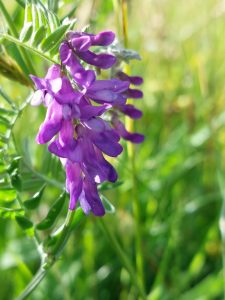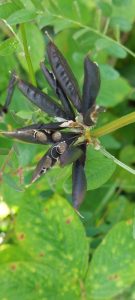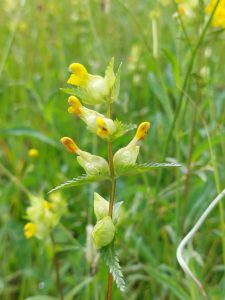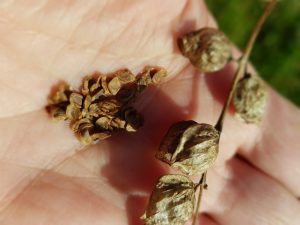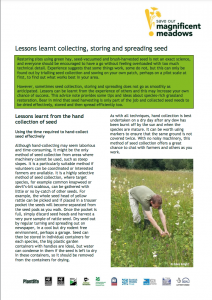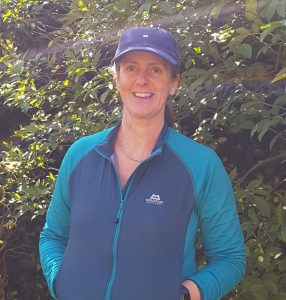Tufted Vetch flower, seed pods and seeds.
It’s feeling a lot like autumn these days, as I sit here in my woolly socks, and you’ll notice seed heads have developed on the flowers in your garden and further afield. This can be a good reminder to collect some native wildflower seed, to help increase the number of wildflowers you have on your farm, in your garden, school or local area.
Collecting and growing wildflowers from seed at home can be very rewarding, and may be easier than you think, so why not give it a go. It’s also a really great way to help our pollinators and it is low cost, too!
It’s best to think about where you want to increase the number of wildflowers before you start – then you’ll have an idea of how many seeds you’ll need to collect and what species might be suitable. You could try Knapweed, Meadow Vetchling, Bird’s-Foot-Trefoil, or any of the vetch species, check out the list at the back of our ‘How-to-Guide’ (details below).
Always remember to get permission from the landowner
to collect seeds and just take a small amount from an area.
The secret to collecting wildflower seed is to follow nature as far as possible. Collect your seeds just before the plant is about to shed them. As the plant begins to brown, the seeds will be ripening, so you should place a paper bag over the top of a flower head, cut the stem and upend the whole thing.
Tie the top of the bag before putting it somewhere to dry. Hang somewhere with good ventilation. It’s also a good idea to write the name of the plant on the bag and location and the date you collected the seed. After a few weeks, check your bags, and you should find seeds at the bottom of each bag. If not, you can give them a shake to help shed the seed.
The seeds of many plants are best sown in autumn as they need a cold winter in order to stimulate germination in spring. If you’re storing the seed until next spring, store in an air-tight container in a cool, dry place.
If you’re just starting out and would like to develop an existing grassland area (it’s best if it’s not too nutrient-rich) into a wildflower meadow, Yellow Rattle is a good wildflower to begin with, and the seeds are lovely and dry just now, making them perfect for collection. Yellow Rattle is also known as the ‘meadow maker’, so if you have part of a lawn or small field that you’d like to become more species-rich with wildflowers, try adding some Yellow Rattle seed to begin with, which will help to reduce the fertility of your grassland area.
Yellow Rattle in flower, and right: Yellow Rattle dried seed pod and seed.
It’s an annual plant and its roots develop underground where they seek out the roots of plants growing nearby, especially grasses. Once contact is made, the Yellow Rattle draws water and nutrients from the grasses, holding back their growth by as much as 60%. In the resulting space, other wildflowers find room to grow.
Sowing Yellow Rattle Seed
Cut and remove the grass cuttings at your chosen site, then sow the Yellow Rattle seed in autumn. Make sure the seed makes contact with bare soil in your lawn or field. The Yellow Rattle will start to grow in the spring – you’ll now need to just cut and lift the grass on your site each autumn. After several years, the Yellow Rattle will have reduced the vigour of the grass, allowing you to sow or ‘plug plant’ other suitable native wildflowers.
You can find out more details in our ‘How-to-Guide – Collecting and using pollinator friendly wildflower seeds’
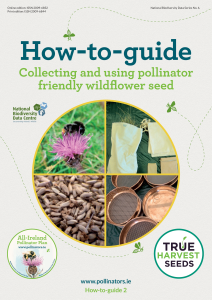
Download How-to-guide: Collecting and using pollinator-friendly wildflower seed
VIDEOS
There are also four very useful videos created by the Yorkshire Dales Millennium Trust’s ‘Wildflowers for the Meadow’ project, which take you through seed collection, processing and sowing, step-by-step.
How to collect Wildflower Seed
Drying and storing Wildflower Seed
How to sow and grow Wildflower Seed
How to plant out Wildflower plug plants
There are exciting new developments in collecting our native Irish wildflower seeds from existing species-rich meadows for habitat restoration. We call these ‘donor wildflower sites’ and the seed is transferred as ‘green hay’ to suitable sites nearby where a native wildflower meadow is being restored.
For larger scale wildflower seed collection, the Save our Magnificent Meadows project, which included sites in Co. Fermanagh and Tyrone, will inspire you. They restored meadows using seed collection by hand, green hay, seed-vacuum and brush harvesting, and they’re forthright about it not being an exact science and have shared the lessons they learnt during the project:
Download Save our Magnificent Meadows Guide
By Ruth Wilson, Farmland Officer, All-Ireland Pollinator Plan

